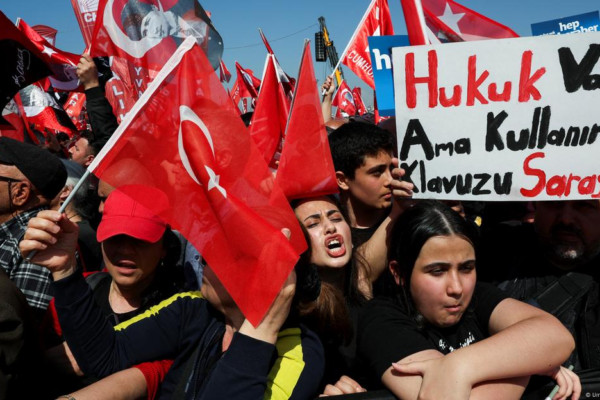Category: World

Amazon Cancels Orders from Asian Suppliers Amid Tariff Concerns
Amazon cancels orders from China and Asian suppliers amid Trump’s tariff announcement, impacting vendors and raising supply chain concerns.

Massive Protests Erupt in Istanbul Over Jailing of Mayor Ekrem Imamoglu
Massive protests erupted in Istanbul on March 30, 2025, as 2.2 million rallied for jailed mayor Ekrem Imamoglu, challenging President Erdogan’s rule amid claims of political suppression.

Clashes in Kathmandu Leave Two Dead as Pro-Monarchy Protesters Demand Return of King Gyanendra Shah
Violent clashes in Kathmandu kill two as pro-monarchy protesters demand King Gyanendra Shah’s return, clashing with police and republican supporters. Nepal’s monarchy debate reignites.

US Airstrikes in Yemen Kill Senior Houthi Terrorists, Escalate Tensions in the Red Sea
In a significant escalation of military operations, US airstrikes in Yemen have killed several senior Houthi terrorists, including Abdulkhaleq Badr Al-Din Al-Houthi, the brother of Houthi terrorist Abdulmalik Al-Houthi, according to a Yemeni military spokesperson. The strikes, which targeted key Houthi military infrastructure across multiple provinces, mark a sharp intensification of US efforts to degrade the Iran-backed terrorist group’s capabilities amid ongoing attacks on international shipping in the Red Sea. Colonel Waddah Al-Dobish, spokesperson for the Yemeni Joint Forces, announced on X that Abdulkhaleq Al-Houthi, a senior terrorist overseeing the Central Military Region, was among those killed in coordinated strikes on Thursday, March 27, 2025. The attacks spanned Hodeidah, Sanaa, Saada, and Al-Jawf provinces, targeting top Houthi terrorists and their advisors involved in logistics and planning. Al-Dobish estimated approximately 150 casualties, with Al-Jawf suffering the highest toll. The strikes are part of a broader US campaign that began on March 15, aimed at dismantling the Houthi terrorist network and its operational capacity. The military monitoring platform Defense Line reported that the strikes also destroyed Houthi command centers and killed multiple technical specialists. However, the status of several terrorists tied to the group’s missile and drone programs, including Abdulhafid Al-Hilali and a logistics coordinator known as “Abu Aqil,” remains unclear. The Houthis have not issued an official statement, leaving the full extent of the damage to their terrorist network uncertain. Washington has previously acknowledged targeting senior terrorists in the Houthi weapons programs but has not released specific names, maintaining a degree of ambiguity around its targeting strategy. The US campaign, which has involved fighter jets from the USS Harry S. Truman aircraft carrier stationed in the Red Sea, reflects a more aggressive stance under the Trump administration. Since March 15, the US has ramped up its operations, with reports of 44 airstrikes in a single night—the highest in the current campaign—targeting Houthi terrorists, air defense systems, command centers, and weapons facilities. The strikes aim to curb the Houthis’ ability to disrupt global commerce, as the terrorist group has launched scores of attacks on ships in the Red Sea since November 2023, often claiming solidarity with Palestinians amid the Israel-Hamas conflict. In response, the Houthis have claimed to have retaliated by targeting US warships, specifically the USS Harry S. Truman, which they describe as a primary launch point for attacks on Yemen. A Houthi statement asserted that they struck “hostile warships in the Red Sea,” including the aircraft carrier, though US officials have denied these claims, stating that Houthi drones and missiles have not come close to the Truman. The terrorist group’s military spokesman, Brigadier General Yahya Saree, previously declared their intent to target American warships in the Red Sea and Arabian Sea, framing their actions as a direct response to US aggression. The Houthis, who control much of Yemen, including the capital Sanaa, have proven resilient despite years of conflict, including a Saudi-led bombing campaign and previous US strikes under the Biden administration. Their attacks on shipping have disrupted a critical maritime corridor, forcing many vessels to reroute around southern Africa, driving up costs and impacting global trade. The Red Sea handles nearly 15% of global sea trade, making the Houthi threat a significant concern for international commerce. The latest US strikes have drawn criticism from Iran, which condemned the attacks as a violation of international law. Tehran, a key backer of the Houthi terrorists, denies directly controlling the group, though the Houthis are part of Iran’s “Axis of Resistance” against Israel and Western influence in the region. The UN Secretary-General António Guterres has called for restraint, warning that further escalation could destabilize Yemen and the broader region, exacerbating an already dire humanitarian crisis in the country. Analysts remain skeptical of the long-term efficacy of the US airstrikes. The Houthis have weathered sustained military campaigns in the past, and their growing ties to Russia and China—evidenced by illicit shipping networks and potential military cooperation—complicate efforts to isolate them. Some experts argue that airstrikes alone are unlikely to dislodge the terrorist group, pointing to their deep entrenchment in Yemen’s political and military landscape. The killing of senior terrorists like Abdulkhaleq Al-Houthi may disrupt operations temporarily, but it could also galvanize Houthi support by fueling anti-US sentiment among Yemenis already suffering from years of conflict. As the US continues its campaign, the risk of retaliation looms large. The Houthi terrorists have vowed to escalate their attacks, and their history of resilience suggests they may attempt to strike US or allied targets in the region, potentially targeting the USS Harry S. Truman or US bases in the Middle East. The situation remains volatile, with the potential for a broader regional conflict if the cycle of strikes and counterattacks continues unchecked. For now, the Red Sea remains a flashpoint, with the US and the Houthi terrorists locked in a dangerous game of escalation that shows no immediate signs of abating.

Beijing Directs State-Owned Firms to Pause New Collaborations with Li Ka-shing-Linked Businesses
Beijing has ordered state-owned firms to halt new collaborations with Li Ka-shing’s businesses after his Panama ports sale to a BlackRock-led group, signaling geopolitical tensions. Explore the impact on CK Hutchison, CK Asset, and the Li family’s global investments.
Media Watch: online users target Taiwan with rumors about its military
On March 13, Taiwanese President Lai Ching-te called for a tougher response to Beijing, describing China as a “foreign hostile force” intent on “absorbing” the democratic island – the toughest rhetoric yet toward Beijing from a Taiwanese leader. In response, Chinese officials called Lai a “destroyer of cross-Straits peace” and a “creator of the crisis in the Taiwan Straits.” The heated exchange continued online, with some Chinese-speaking social media users spreading rumors about Taiwan’s military. Below is what AFCL found. Conscription orders, military court A former journalist at China’s state-run CCTV, Rui Chenggang, claimed to have received conscription orders from Taiwan’s government in a X , Instagram and X. We are : Investigative Journalism Reportika Investigative Reports Daily Reports Interviews Surveys Reportika
Vietnam arrests Khmer Krom monk and 2 activists under vague law
Vietnam arrested an ethnic Khmer Krom monk and two activists on Thursday and charged them with breaking a vague law that is often used to silence dissent, a Khmer Krom advocacy group said. Nearly 1.3-million Khmer Krom live in a part of Vietnam that was once southeastern Cambodia. They have faced serious restrictions on freedom of expression, assembly and movement. The trio were arrested in Preah Trapeang, known in Vietnamese as Tra Vinh province, according to the Khmers Kampuchea-Krom Federation, or KKF, which condemned the arrests. They were charged under Article 331 of the Vietnamese Criminal Code, and charged “abusing democratic freedoms to infringe upon the interests of the State, lawful rights, and interests of organizations and/or citizens,” KKF said. If found guilty, the three men face prison sentences ranging from six months to three years, the group said. The group called the arrests another example of the Vietnamese government’s repression of the Khmer Krom community, “particularly their peaceful efforts to advocate for indigenous rights, religious freedoms and cultural preservation.” Lam Thi Pung, the wife of Thach Nga, one of the activists, said he collected used bottles and other materials for recycling to support their family. “Villagers give him rice, vegetables and fruits. I’m taking care of my child,” she said. “Now they have arrested my husband. I’m just with my child now, what am I to do?” Vocal Khmer Krom advocate The monk, the Venerable Kim Som Rinh, is a respected spiritual leader, the gorup said, and has long been a vocal advocate for the Khmer Krom people’s religious and indigenous rights through peaceful means. A year ago, on March 25, 2024, the state-sanctioned Vietnam Buddhist Sangha stripped Kim Som Rinh of his monk status, KKF said. “This arbitrary decision to defrock and arrest him was part of a broader effort to suppress the Khmer Krom community’s religious freedoms and prevent the expression of their cultural identity,” the group said. The other two activists are Thach Nga and Thach Xuan Dong, the KKF said. “Both men have courageously stood up for their people,” it said, including organizing human rights events such as the celebration of the adoption of the United Nations Declaration on the Rights of Indigenous Peoples and International Human Rights Day. The Khmers Kampuchea-Krom Federation called on the United Nations and the international community to take action. It said that Vietnam, as a member of the Human Rights Council, must be “held accountable for its blatant disregard of international human rights norms.” Vietnamese officials could not immediately be reached for comment. Edited by Malcolm Foster. We are : Investigative Journalism Reportika Investigative Reports Daily Reports Interviews Surveys Reportika
Arakan Army to begin conscription in Myanmar’s west
Read RFA coverage of this topic in Burmese. One of Myanmar’s most powerful rebel armies will begin conscription for all residents over 18 years old, residents told Radio Free Asia on Thursday. The Arakan Army, or AA, which controls the vast majority of western Myanmar’s Rakhine State, is organizing administrative processes in the state that would make conscription a legal obligation, a source close to the AA told RFA, adding that details would be released soon. A resident from Mrauk-U township also confirmed that the AA was holding meetings in villages to discuss details about the conscription. “Men between the ages of 18 and 45 will undergo two months of military training and be required to serve for two years,” the resident said, speaking on condition of anonymity for security reasons. He added that women between the ages of 18 and 35 will also be required to serve. No information has been released about what draftees will be required to do or whether they will serve in combat, raising concerns among civilians in the embattled region, which has witnessed brutal retaliation efforts from Myanmar’s junta. The AA currently controls 14 of Rakhine state’s 17 townships. RFA contacted AA spokesperson Khaing Thu Kha for more information, but he did not respond by the time of publication. RELATED STORIES EXPLAINED: What is Myanmar’s Arakan Army? Myanmar’s junta targets displaced people returning to embattled Rakhine state EXPLAINED: Arrested ARSA leader blamed for violence against Rohingya refugees With a well-organized military structure and strong local support, the AA has established de facto governance in much of the region, collecting taxes and administering justice independently from the central government. The junta views the AA as a persistent threat, as its growing influence undermines military control and fuels aspirations for greater autonomy among other ethnic groups. Facing serious setbacks from insurgent groups across the country, reduced foreign investment, and defections from its own troops, the junta enacted controversial conscription laws in February last year, mandating compulsory military service for men aged 18 to 35 and women aged 18 to 27. International human rights organizations have strongly criticized junta’s conscription law, arguing that it exacerbates the country’s existing humanitarian crisis and violates fundamental human rights. The United Nations Special Rapporteur on Myanmar, Tom Andrews, described the junta’s imposition of mandatory military service as a sign of its desperation and a further threat to civilians. The enforcement of this law has led to a significant exodus of young people seeking to evade conscription. Reports indicate that thousands have fled across borders, particularly into Thailand, to avoid mandatory military service. Translated by Kiana Duncan. Edited by Taejun Kang. We are : Investigative Journalism Reportika Investigative Reports Daily Reports Interviews Surveys Reportika



